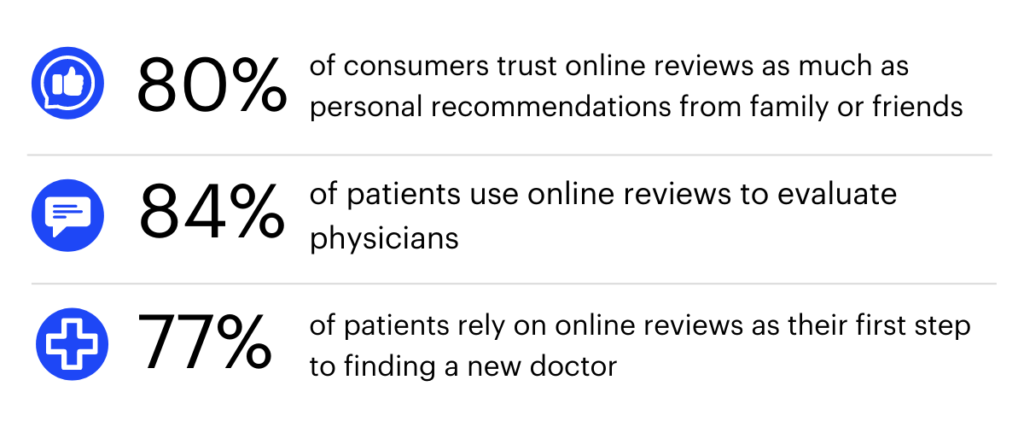Your online reputation is critical to your practice’s growth plan. The reason? Most patients start their healthcare journeys by reading online reviews. Practices that encourage frequent reviews of their facilities, providers, staff, and services can improve patient acquisition and retention while also adding the bonus of identifying opportunities for improvement.
During a May virtual session hosted by Becker’s Hospital Review and sponsored by Podium, Hally Pinaud, Vice President of Product Marketing at Podium, and Paige Entwisle, Digital Content Supervisor at Ochsner Health—Louisiana’s largest nonprofit academic healthcare system—discussed how healthcare practices can create a review-based culture.
Here are two key takeaways from the discussion:
→Online reviews are critical for patient acquisition, growth, and retention.
According to Hally, who cited a Healthgrades blog, 84% of patients use online reviews to evaluate physicians, 80% of consumers trust online reviews as much as personal recommendations from family or friends, and 77% of patients rely on online reviews as their first step to finding a new doctor. “This is truly what we consider digital word-of-mouth,” Hally said.

→Ochsner Health embarked on an online review initiative to better establish its brand.
This initiative was really part of a bigger campaign to create more brand prominence, loyalty, and affinity with all of those they serve. While Ochsner had started an online reputation management program in 2014, the organization realized it needed a more robust online presence.
Ochsner started by creating a Google business listing for 13 of its urgent care locations, which quickly expanded to all 150 of its facilities. They found that when people were searching “urgent care,” they weren’t always surfacing. They realized that was because not all of their Urgent Care centers had reviews. After piloting a review request program, Ochsner saw a 400% increase in positive reviews. Ochsner then made the decision to expand its review request program system-wide.
Five Ways to Create a Review-Based Culture
Based on Ochsner’s experience and Podium’s expertise, Hally and Paige offered the following pro tips for successfully creating a review-based culture:
Establish expectations.
The first step is always to get executive buy-in. Ochsner’s expectation was that a patient would be asked to leave a review after every contact. The second step is to work with providers who may be apprehensive about potential negative reviews—the idea of reviews makes people a little self-conscious about their bedside manner. Finally, it’s essential to set expectations with the administrative staff because they will be the ones doing the service recovery after a negative review.
Set clear goals.
Without clear goals, your focus on reviews will fall flat. Ochsner’s marketing and communications goals focused on patient acquisition and retention, employee and patient experience, and improving brand prominence and affinity.
Incentivize success.
Most businesses believe that incentivizing employees will positively impact the number of reviews collected. Although it’s important to customize incentives to the practice and its employees, some common incentives include a monthly bonus, a leaderboard that showcases top performers, monthly raffles for all who help patients submit reviews, gift cards or discounts, and days off. A tip is to get creative with competitions and rewards for reviews.
Share wins and correct failures.
Ochsner regularly receives an overwhelming number of positive reviews, and they believe it’s important to publicly shout out wins with staff and employees. But, it’s equally important to view negative reviews as an opportunity to improve. In 2021, Ochsner had 331 negative reviews that were escalated and they were able to recover 126 of those patients. Then, during COVID-19, they noticed a trend in their Baton Rouge region around wait time. After digging into this issue, Ochsner realized the Baton Rouge team was using the wrong type of thermometers on people coming through the drive-thru. They were able to identify that issue and bring it to that facility’s attention for resolution.
Track results.
If you fail to track your results, you can’t see if you’ve met your goals. Ochsner publishes an online reputation management impact report on a quarterly and annual basis. They have been able to use results to discover new things we want to look into. For example, they’ll do targeted surveys for particular providers or create new programs around branding and way-finding. In other words, they’re using their results to create new goals.
By using tools like Podium, healthcare practices can create and facilitate a successful online review program and collect comprehensive data that can turn into actionable insights.
To learn more about Becker’s virtual events, click here



